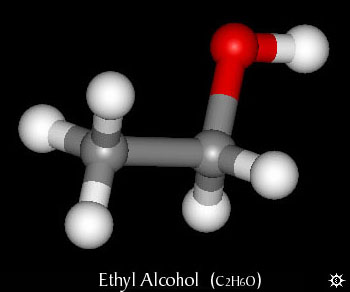by Erowid
| NAME : | Ethyl Alcohol |
| CHEMICAL NAME : | Ethanol |
| ALTERNATE CHEMICAL NAMES : | absolute alcohol; anhydrous alcohol; dehydrated alcohol |
| ALTERNATE CHEMICAL NAMES : | ethyl hydrate; ethyl hydroxide |
| CHEMICAL FORMULA | C2H6O |
| MOLECULAR WEIGHT | 46.07 |
| MELTING POINT | -114.1° C |
| BOILING POINT | 78.5° C |
| FLASH POINT | 13° C |
| LD50 | 10.6 g/kg (young rats), 7.06 g/kg (old rats) orally |
| From the Merck Index 12th Edition | |
|---|---|

Methanol (wood alcohol, poisonous to humans) Material Safety Data Sheet
MERCK INDEX ENTRY
3806. Ethyl Alcohol. Ethanol; absolute alcohol; anhydrous alcohol; dehydrated aocohol; ethyl hydrate; ethyl hydroxide. C2H6O; mol wt 46.07. C 52.14%, H 13.13%, O 34.73%. C2H5OH. Manuf: by fermentation of starch, sugar, and other carbohydrates; from ethylene, acetylene sulfite waste liquors, and synthesis gas (CO + H); by hydrolysis of ethyl sulfate, and oxidation of methane. Toxicity: G.S. Wiberg et al., Toxicol. Appl. Pharmacol. 16, 718 (1970). Embryotoxicity in mammals: N.A. Brown et al., Science 206, 573 (1979), Posibble mechanism for actions of ethanol on the brain: G. Aston-Jones et al., Nature 296, 857 (1982). Ethanol-induced chromosomal abnormalities in mice: M. H. Kaufman, ibid. 302, 258 (1983). Disruption of reproductive function in female primates following alcohol self-administration: N.K. Mello et al., Science 221, 677 (1983). review of metabolism and toxicity: C.S. Liever in Reviews in Biochemical Toxicology vol. 5., E. Hodgson et al., Eds. (Elsevier, New York, 1983) pp 267-312; of pharmacology: L. Pohorecky, J. Brick, Pharmacol. Ther 36, 335-427 (1988); of hepatotoxicity: C. S. Liever, L.M. DeCarli, J. Hepatol. 12, 394-401 (1991). General reviews: P. Baud, "Ethyl Alcohol Industry" in Grignard, Traite de Chimie Oranique vol. 5 (Masson, 1937) pp 841-975; Zabel, Chem Inds. (now Chem. Week) 64, 212 (1949); Faith, Keyes & Clark's Industrial Chemicals, F.A. Lowenheim, M.K. Moran, Eds. (Wiley-Interscience, New York, 4th ed., 1975) pp 355-364; P.D. Sherman, P.R. Kavasmaneck, "Ethanol" in Kirk-Othmer Encyclopedia of Chemical Technology vol. 9 (Interscience, New York, 3rd ed., 1980) pp 338-380.
Clear, colorless, very mobile, flammable liquid; pleasant odor; burning taste. Absorbs water rapidly from air. d20/4 0.789. bp 78.5°. mp-114.1°. n20/D 1.361. Flash pt, closed cup: 13° C. Miscible with water and with many organic liquids. Keep tightly closed, cool, and away from flame! LD50 in young, old rats (g/kg): 10.6, 7.06 orally (Wisberg).
The terms 95% alcohol and alcohol (when used alone) refer to a binary azeotrope having a distillate composition of 95.57% ethyl alcohol (by wt) and bp 78.15°. Alcohol, USP is specified as containing not less than 92.3% and not more than 93.8% by weight, corresponding to not less than 94.9% and not more than 96.0% by vol of C2H5OH at 15.56°. d25/25 0.810; d 0.816 at 15.56° (60° F). Diluted alcohol, prepd from equal vols 95% alcohol and water, contains about 41.5% by wt or about 48.9% by vol of C2H5OH. d25/25 0.931; d 0.936 at 15.56° (60° F). See U.S.P. XXI, 22, 1530 (1985).
Caution: Nausea, vomiting, flushing, mental excitement or depression, drowsiness, impaired perception, incoordination, stupor, coma, death may occur, cf. Clinical Toxicology of Commercial Products, R. E. Gosselin et al., Eds. (Williams & Wilkins, Baltimore, 5th ed., 1984) Section III, pp 166-171.
USE: Most ethyl alcohol is used in alcoholic beverages in suitable dilutions. Other uses are as solvent in laboratory and industry, in the manufacture of denatured alcohol, pharmaceuticals (rubbing compds, lotions, tonics, colognes), in perfumery, in organic synthesis. Octane booster in gasoline. Pharmaceutic aid (solvent).
THERAP CAT: Antiseptic.
THERAP CAT (VET): Antiseptic. To destroy nerve tissue. Solvent and dehydrating agent.


